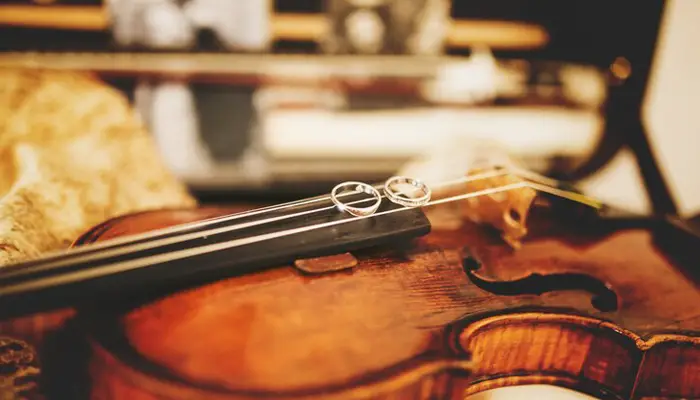
Reading music is an essential skill for cellists of all levels. In order to learn how to play a piece of music, you must first be able to read the notes on the page. This tutorial will teach you how to read cello music correctly and efficiently.
We will cover everything from basic notation to more advanced concepts such as slurs and articulations. By the end of this lesson, you will be able to interpret any piece of sheet music!
How to Read Cello Music
Basic Notation
To embark on our journey, let’s first explore the foundational elements of cello notation. While the treble clef, also known as the “G Clef,” represents higher notes, cello music predominantly employs the bass clef, indicating lower pitches. The staff, consisting of five horizontal lines, serves as the canvas upon which musical notes are placed.
Notes progress from left to right, with higher pitches situated towards the right side of the staff. Familiarizing oneself with these fundamentals lays a solid groundwork for further exploration.
Note Duration
A crucial aspect of reading cello music is understanding note durations, which dictate the length of time a note is played. Let’s break down the six basic note durations:
1. Whole Notes
Whole notes, denoted by a hollow oval, are fundamental elements of musical notation. They symbolize sustained sounds and endure for the duration of four beats in common time signatures, such as 4/4. Whole notes serve as pillars of stability within musical phrases, providing a foundation upon which melodic and harmonic developments unfold.
Their extended duration allows for profound musical expression and resonance, lending richness and depth to compositions across various genres and styles.
2. Half Notes
Half notes, characterized by a hollow oval with a stem, occupy a significant place in rhythmic structures. With a duration of two beats in common time signatures, half notes offer a balanced rhythmic flow, bridging the gap between longer whole notes and shorter rhythmic values.
Their versatility allows for the creation of rhythmic patterns that are both compelling and accessible to performers and listeners alike. Half notes contribute to the rhythmic pulse of a piece, guiding the listener through its melodic contours with clarity and grace.
3. Quarter Notes
Quarter notes, akin in appearance to half notes but distinguished by a single stem, are ubiquitous in musical compositions. Spanning one beat in common time signatures, such as 4/4, quarter notes inject energy and momentum into musical phrases.
Their succinct duration facilitates rhythmic precision and articulation, enabling performers to navigate intricate rhythmic patterns with agility and confidence. Quarter notes serve as building blocks of rhythm, driving forward the musical narrative with vitality and dynamism.
4. Eighth Notes
Eighth notes, characterized by two connected hollow ovals with a stem, introduce rhythmic intricacy and syncopation to musical passages. Lasting half a beat in common time signatures, eighth notes enhance rhythmic diversity and complexity, infusing compositions with vitality and forward motion.
Their rapid succession creates a sense of fluidity and momentum, propelling the music forward with dynamic energy. Eighth notes are essential components of syncopated rhythms and embellishments, adding texture and depth to musical performances across genres.
5. Sixteenth Notes
Sixteenth notes, comprised of four connected hollow ovals, occupy a crucial role in shaping rhythmic patterns and textures. Enduring for a quarter of a beat in common time signatures, sixteenth notes contribute to the agility and fluidity of musical passages.
Their rapid succession creates intricate rhythmic motifs and embellishments, adding excitement and dynamism to compositions. Sixteenth notes enable performers to execute complex rhythmic patterns with precision and flair, enhancing the overall musical expression and impact.
6. Thirty-Second Notes
Thirty-second notes, distinguished by eight connected hollow ovals, represent the pinnacle of rhythmic intricacy and precision. Persisting for one-sixteenth of a beat in common time signatures, thirty-second notes contribute to the intricate tapestry of rhythmic patterns with their rapid succession and precise articulation.
Their inclusion adds depth and complexity to musical compositions, challenging performers to execute passages with speed and accuracy. Thirty-second notes are often utilized in virtuosic passages and flourishes, showcasing the technical prowess and artistry of performers.
Practical Application:
With a solid grasp of basic notation and note durations, it’s time to apply this knowledge to practical exercises. Begin by practicing simple melodies or etudes that incorporate various note values, gradually increasing the complexity as proficiency grows.
Additionally, familiarize yourself with the layout of cello strings, numbered from low to high: one through four. This understanding facilitates efficient navigation of musical scores, enhancing fluency and accuracy in performance.
Conclusion: How to Read Cello Music
In conclusion, mastering the art of reading cello music is a journey of exploration and growth. By understanding basic notation, note durations, and practical application techniques, aspiring cellists can unlock the door to a world of musical expression and creativity.
Remember, dedication and perseverance are key on this musical odyssey. So, pick up your cello, immerse yourself in the beauty of the music, and let your journey begin. Happy playing!
Frequently Ask Questions
What are the notes for cello?
Cello music is predominantly notated in the bass clef, signifying lower pitches compared to the treble clef.
How do you read cello strings?
Cello strings are numbered from low to high, with the lower strings producing deeper tones, progressing to higher-pitched notes.
How do you memorize cello notes?
Memorizing cello notes requires consistent practice and exposure. Begin by familiarizing yourself with note placements on the staff and gradually incorporate advanced techniques such as scale and arpeggio exercises.
You can also check out How Much Does a Cello Cost and Difference Between a Bass and Cello.


